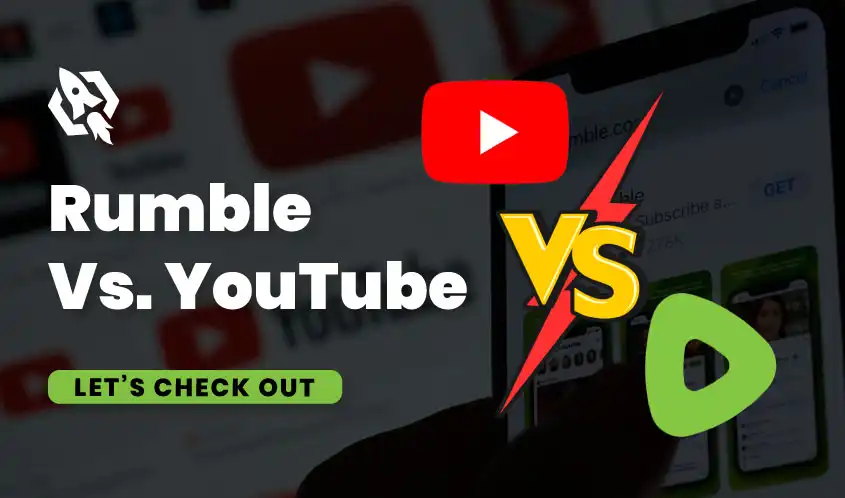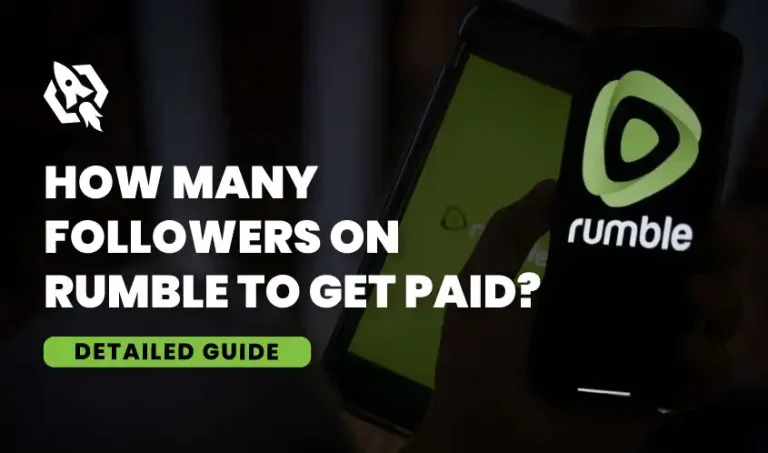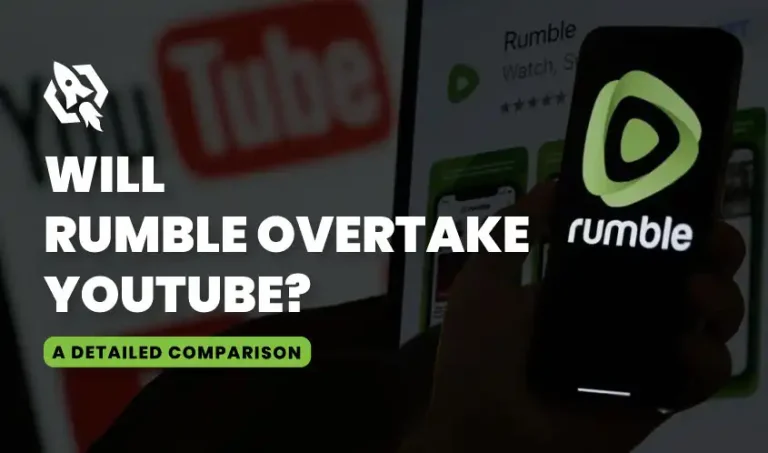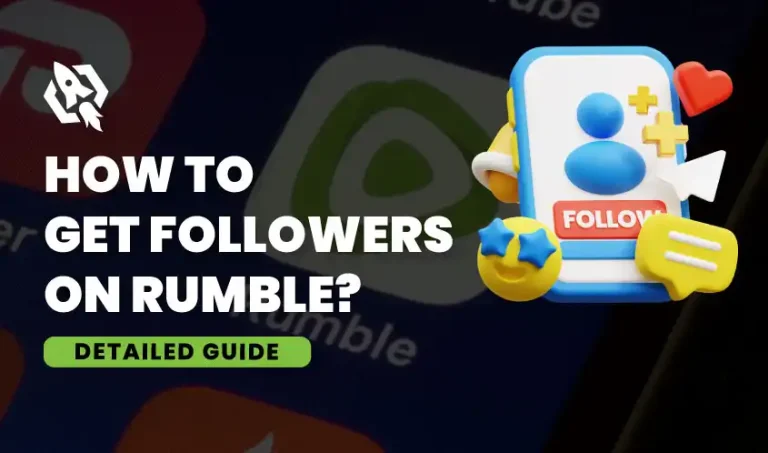Platforms for sharing videos have completely changed how we generate and use media. Content creators are always searching for the greatest places to share their work, interact with their audience, and develop their brand as new platforms appear and change. Rumble and YouTube are two examples of such sites that have attracted a lot of interest.
Two well-known video-sharing websites that give content creators a place to showcase their work are Rumble and YouTube. Both systems have their own special qualities and advantages, but they also differ greatly from one another.
While YouTube is the veteran giant in the video-sharing world, Rumble is a relatively new player, gaining traction with its promise of creator-friendly policies and monetization options.
In this comparison guide, we’re going to compare the specifics of both platforms, contrasting their features, prospects for revenue generation, audience size, and other aspects. By the time it’s over, you’ll know enough to choose the platform that works best for your content requirements for production.
Overview of Rumble and YouTube Platform
YouTube: The Industry Giant
Launched in 2005, YouTube has become synonymous with online video sharing. YouTube is the second most popular website in the world, with over 2 billion monthly active users and a vast content library that includes everything from music videos to instructional guides. It’s a platform where viral sensations are born, careers are made, and communities are formed.
Rumble: The Rising Star
Rumble, on the other hand, was launched in 2013 with a mission to provide content creators with better earning opportunities and more control over their content. It has gained popularity for its commitment to free speech and less restrictive content policies. While not as massive as YouTube, Rumble is gaining a foothold, especially among creators who feel restricted by YouTube’s stringent policies.
What is Rumble Platform?
Rumble is a relatively new video-sharing platform that has been gaining traction, particularly among conservative content creators and audiences. Founded in 2013 by Chris Pavlovski, Rumble aims to provide a level playing field for content creators by minimizing censorship and offering fair monetization opportunities. The platform has positioned itself as a transparent alternative to mainstream platforms, emphasizing free speech and content creator rights.
Key Features of Rumble
- Ease of Use: Rumble’s user interface is designed to be straightforward and easy to navigate.
- Monetization: Rumble offers multiple monetization options, including ad revenue sharing, licensing, and syndication.
- Censorship: Rumble promotes itself as a platform with minimal censorship, making it attractive to those concerned about content filtering.
- Audience: While it started with a niche audience, Rumble is expanding and diversifying its user base.
- Analytics: Provides basic analytics to help you track the performance of your videos.
What is YouTube?
YouTube, launched in 2005 and acquired by Google in 2006, is a video-sharing platform where users can create, upload, and share videos with the world. YouTube has a huge selection of content, such as vlogs, music videos, instructional videos, and much more. It also gives content producers the chance to monetize their work and grow a fan base. In the digital age, YouTube is an effective resource for communication, education, and entertainment. So, it offers a unique opportunity for content creators to reach a large audience and potentially earn revenue from their videos. YouTube is still one of the best platforms for content makers because of its large user base and advanced statistics.
Key Features of YouTube
- Monetization: YouTube offers diverse monetization options such as ad revenue, channel memberships, Super Chats, and merchandise shelves.
- Censorship: YouTube has community guidelines and policies that can lead to content removal or demonetization.
- Audience: With a global audience, YouTube offers unparalleled reach.
- Analytics: Comprehensive statistics are available on YouTube, providing information on demographics, video performance, and viewing activity.
- Community Features: Includes features like comments, likes, and shares to foster community interaction.
How Are These Two Platforms Different?
While both Rumble and YouTube are video-sharing platforms, they cater to different audiences and offer distinct features.
1. Audience Reach
When choosing which platform to employ for content creation, one of the most important things to take into account is the audience reach of Rumble and YouTube. While both platforms have a large user base, there are significant differences in the reach and engagement opportunities they offer.
- YouTube: YouTube has a much larger audience reach than Rumble. With more than 2 billion active users each month, YouTube is the second-largest search engine in the world. This implies that YouTube video has the ability to be seen by a large audience and has the chance to go viral and get attention.
- Rumble: Rumble’s audience is still relatively smaller than that of YouTube. However, Rumble has been steadily growing and gaining popularity in recent years due to its commitment to free speech and less restrictive content policies. This niche audience on Rumble is often more dedicated and engaged, making it easier for creators to build a loyal following and reach their target audience.
2. Content Regulation
Both platforms have their own set of content policies and guidelines for creators to follow.
- Rumble: It is known for its minimal censorship policies, making it appealing to those who feel restricted by other platforms. Rumble takes a more hands-off approach when it comes to content regulation. As a platform that values free speech, Rumble allows a wider range of content and is more lenient with its policies. This may appeal to creators who prioritize creative freedom and don’t want to risk their content being censored or removed. However, this also means that there may be a higher chance of encountering inappropriate or offensive content on the platform.
- YouTube: YouTube has a more stringent approach to content regulation, with strict community guidelines and a robust system for flagging and removing inappropriate or offensive content. While this may limit some creators’ ability to post certain types of content, it also ensures a safer and more family-friendly platform for all users. It enforces strict community guidelines that can result in content removal or demonetization.
3. User Interface
When contrasting Rumble and YouTube as platforms for creating content, it’s also critical to take into account their user interfaces. A smooth and user-friendly interface can greatly impact the overall experience for both creators and viewers.
- Rumble: Rumble’s interface may appear more cluttered and less intuitive than YouTube’s. However, it offers unique features such as the ability to upload videos directly from mobile devices and the option to monetize videos through a royalty program. Additionally, Rumble’s interface may appeal to creators who prefer a more minimalist design, as it focuses primarily on video content without distractions.
- YouTube: YouTube’s interface is well-known and familiar to most users, with a clean layout and easy navigation. The search function allows users to easily find specific videos or channels, while the recommended videos section can help discover new content. The platform also offers a variety of features, such as playlists, live streaming, and community engagement tools to enhance the user experience.
4. Video Discovery
Video discovery is a key factor to consider when comparing Rumble and YouTube as content creation platforms. This refers to how easily users can find and discover new videos on each platform, as well as the tools available for creators to promote their content.
- Rumble: Video discovery is straightforward but less sophisticated than YouTube’s algorithm. It may not be as robust as YouTube’s. Its search function is more limited, and there are fewer options for promoting content. But Rumble has a more specialized and smaller community, which is advantageous for content producers that want to cater to a certain market or niche. Additionally, Rumble offers the ability to monetize videos through its royalty program, providing an additional incentive for creators to promote their content on the platform.
- YouTube: It presents content for users through an extremely sophisticated recommendation system. The suggested videos section and robust search algorithms on YouTube facilitate the process of finding new content for users. Additionally, the platform offers various features such as playlists, hashtags, and trending topics to help promote videos and increase their visibility. YouTube also has a large and diverse user base, making it easier for creators to attract new viewers and potential subscribers.
5. Quality of the Video
Both platforms have their own standards and requirements for video quality, which can impact the viewing experience for audiences.
- Rumble: Rumble has slightly more relaxed guidelines for video quality. The minimum resolution for a video on Rumble is 480p, and the recommended standard is also 1080p. However, Rumble only supports videos in a 16:9 aspect ratio, which may limit creators who want to upload content in different ratios.
- YouTube: YouTube has been around for over 15 years and has established itself as a leader in online video sharing. To maintain its high-quality standards, YouTube has strict guidelines for video resolutions, aspect ratios, and file formats. For example, the minimum resolution for a video on YouTube is 240p, while the recommended standard is 1080p. This ensures that videos are clear and sharp, even when viewed on larger screens. Also, YouTube supports various aspect ratios, such as 16:9 and 4:3, to accommodate different devices.
What is the Difference in Monetization Opportunities?
Monetization is a crucial factor for content creators. Here’s how Rumble and YouTube stack up against each other in this regard.
Rumble’s Monetization Options
- Ad Revenue Sharing: Based on how many times a video is seen, Rumble pays ad income to content creators.
- Licensing: Rumble offers licensing opportunities where creators can sell their content to media outlets.
- Syndication: Content can be syndicated across other platforms and channels, increasing reach and revenue potential.
- Exclusive Content Deals: For high-performing creators, Rumble offers exclusive content deals.
YouTube’s Monetization Options
- Ad Revenue: The advertising that appears on creators’ videos generate revenue for them.
- Channel Memberships: For a monthly subscription, viewers can subscribe to channels, giving creators a reliable source of income.
- Super Chats & Super Stickers: Viewers who would like to have their messages emphasized during live streaming can pay.
- Merchandise Shelf: Artists can use their YouTube channel to directly sell items.
- YouTube Premium Revenue: When users of YouTube Premium watch material from creators, they get paid a portion of the membership cost.
Main Differences Between YouTube and Rumble
When comparing Rumble and YouTube, several key differences stand out:
1. Freedom of Content
- Rumble: Minimal content censorship, making it a haven for creators concerned about free speech.
- YouTube: Stricter content guidelines and policies that can lead to demonetization or content removal.
2. Monetization Structure
- Rumble: Offers multiple revenue streams, including ad revenue sharing, licensing, and syndication.
- YouTube: Provides a variety of monetization options, including ads, memberships, Super Chats, and merchandise.
3. Audience Engagement
- Rumble: These are more straightforward engagement tools that are suitable for creators looking for simplicity.
- YouTube: Extensive community features, including comments, likes, shares, and polls.
4. Analytics and Insights
- Rumble: Basic analytics to track video performance.
- YouTube: Robust analytics that offers deep insights into viewer behavior and video performance.
Benefits of Both Platforms
Both Rumble and YouTube offer unique benefits that cater to the different needs and preferences of content creators and social media users.
Benefits of Rumble
- Creative Freedom: Rumble takes a more hands-off approach when it comes to content regulation compared to other platforms like YouTube. This implies that content producers are less restricted to create any kind of content they like without worrying about it being censored or taken down.
- Monetization Opportunities: Rumble offers various monetization options for creators, including their royalty program and the ability to sell content directly through their platform. This can be a lucrative opportunity for creators looking to make money from their videos.
- Niche Audience: Rumble’s community is more niche and focused on specific topics or interests. This can be beneficial for creators looking to target a specific audience and build a dedicated following.
- Direct Mobile Uploads: Rumble allows creators to upload videos directly from their mobile devices, making it convenient and efficient for on-the-go content creation.
- Minimalistic Interface: Rumble’s interface is designed to primarily showcase video content without distractions, making it more visually appealing and user-friendly for viewers.
- Support for Independent Creators: Rumble prioritizes and supports independent creators, providing a platform for them to showcase their content without the need for a large following or established brand.
Benefits of YouTube
- Established Audience: With billions of users worldwide, YouTube has a vast audience and potential for creators to reach a wide and diverse audience.
- Advanced Analytics: YouTube provides detailed analytics for creators to track the performance of their videos and better understand their audience’s behavior.
- Community Engagement: YouTube has a strong sense of community, with features such as comments, likes, and shares allowing creators to engage and interact with their audience.
- Integration with Google Services: As an extension of Google, YouTube integrates seamlessly with other services like Google Ads and Analytics, providing additional opportunities for monetization and expanding reach.
- Searchability: Users can find fresh content more easily because to YouTube’s advanced search algorithms, which raises the possibility of views and interaction.
- Creative Tools: YouTube offers various creative tools such as end screens, cards, and subtitles to enhance the viewing experience and engage with viewers.
- Familiar Interface: As one of the most popular video-sharing platforms, YouTube’s interface is familiar to many users, making it easy to navigate and use.
Choosing the Right Platform Between Rumble and YouTube
Ultimately, the choice between Rumble and YouTube depends on your specific needs, goals, and audience.
Choose Rumble If:
- You prioritize minimal censorship and free speech.
- You are looking for multiple monetization avenues.
- You prefer a simple and straightforward user interface.
- You want to tap into a growing, niche audience.
Choose YouTube If:
- You seek a massive global audience for maximum exposure.
- You value diverse monetization options, including memberships and merchandise.
- You need advanced analytics to optimize your content.
- You want extensive community features to engage with your audience.
FAQs:
YouTube is a well-established video-sharing platform with a large and diverse audience, while Rumble is a newer platform that caters to more niche interests.
YouTube offers various features such as playlists, hashtags, and trending topics to help promote videos. Rumble has fewer options but allows for direct mobile uploads and a royalty program for monetization.
Yes, both platforms offer monetization opportunities for creators. YouTube has various options, such as ads, sponsorships, and merchandise sales, while Rumble offers its royalty program and direct content sales.
Both platforms offer support and opportunities for independent creators, but Rumble specifically prioritizes and highlights independent creators on their platforms.
Conclusion
Both Rumble and YouTube offer unique advantages and cater to different needs within the content creation ecosystem. By understanding the distinct features, monetization opportunities, and audience engagement tools each platform provides, you can make an informed decision about which one aligns best with your goals.
Whether you choose Rumble for its minimal censorship and flexible monetization or YouTube for its massive reach and advanced features, the key is to leverage the strengths of your chosen platform to create engaging, high-quality content that resonates with your audience.
Ready to start your content creation journey? Evaluate your priorities, understand your audience, and choose the platform that best fits your needs.




